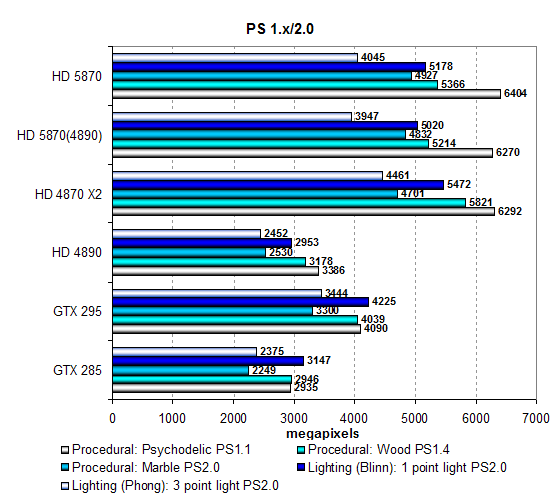Synthetic tests
Testbed:
- Intel Core I7 CPU 920 (2,667 MHz) CPU
- ASUS P6T Deluxe motherboard with the Intel X58 chipset
- 3GB DDR3 SDRAM Corsair 1066MHz
- WD Caviar SE WD1600JD 160GB SATA hard drive
- Tagan TG900-BZ 900W PSU
- Windows Vista 32-bit SP1, DirectX 10.1
- Dell 3007WFP 30-inch monitor
- ATI CATALYST 9.9; NVIDIA 191.00 drivers
- VSync disabled
Our synthetic benchmarks:
Unfortunately, the time of DirectX 11 synthetic tests hasn't come yet. We haven't heard of such tests yet, and our RightMark doesn't support it yet (we hope it's only a matter of time). Besides, there is nothing we can compare HD 5870 with, and we don't have the second card for a CrossFire configuration.
Tested graphics cards:
- RADEON HD 5870
- RADEON HD 5870, memory operating at 975(3900) MHz (HD 5870 (4890))
- RADEON HD 4870 X2
- RADEON HD 4890
- GeForce GTX 295
- GeForce GTX 285
We selected these graphics cards to compare with the new RADEON HD 5870 for the following reasons: The RADEON HD 4890 was the fastest single-GPU model from AMD, and the HD 4870 X2 had been the fastest solution before that. The same with NVIDIA cards: GeForce GTX 285 is company's fastest single-GPU card and the GTX 295 is a powerful dual-GPU solution.
The diagrams also show a "modification" of the new RADEON HD 5870 that has video memory clock rate reduced. It was done to compare it with the previous generation of cards (HD 4890) at the same frequencies. And to determine whether the new graphics card is limited by memory bandwidth.
Direct3D 9: pixel filling tests
This test determines peak texel rate in FFP mode for different numbers of textures applied to a pixel:
This test is a little outdated, and graphics cards do not reach their theoretical maximum here, it still shows well relative ratings of graphics cards. Results of this synthetic test do not reach peak values. It turns out that the Cypress looks up about 60 texels per cycle from 32-bit textures with bilinear filtering, while the theoretical maximum here is 80 filtered texels.
It's enough to outscore the HD 4870 X2 and become a leader among all graphics cards (considering that GTX 295 has problems with its drivers). Perhaps, the dual-GPU card from NVIDIA could have struggled for leadership, but some SLI problems made it impossible.
Interestingly, a difference between the HD 5870 and HD 4890 does not always correspond to twofold even at the same frequencies. In case of just a few textures, performance is limited by memory bandwidth. But when the number of textures reaches 4-6, there is approximately a twofold difference. It grows bigger with 8 textures, which may indicate a different balance towards more textures. Let's have a look at the fill rate results:
The second synthetic test measures the fill rate. It shows the same situation adjusted for the number of pixels written into the frame buffer. Maximum result is still demonstrated by the new solution from AMD. In case of 0, 1, and 2 textures, performance difference between solutions is smaller, because performance in mostly limited by memory bandwidth in such modes. But the new graphics card from AMD outperforms all its competitors even in situations with more textures per pixel.
Direct3D 9: pixel shaders tests
The first group of pixel shaders to be reviewed here is too simple for modern GPUs. It includes various versions of pixel programs of relatively low complexity: 1.1, 1.4, and 2.0.
They fail to reveal the true GPU power, but they help evaluate the balance between texture lookups and arithmetic operations, especially when architectures change. Performance in these simple tests is limited mostly by the speed of texturing units. Let's look for changes in the architecture in comparison with the RV770. It seems that there are no major modifications, the new graphics card demonstrates results similar to those of the prev-gen card with allowance for a different number of execution units and general efficiency.
Memory bandwidth in these tests limits the new solutions only a little, but it's almost always close to the prev-gen dual-GPU solution. Graphics cards based on NVIDIA GPUs are utterly defeated -- a good start that promises victories in other tests. The HD 5870 is not twice as fast as the HD 4890 at the same frequencies, but it may be the effect of insufficient memory bandwidth. Let's have a look at results in more complex pixel programs of intermediate versions:
They are a bit more interesting, although the lighting test shows similar results. The procedural water test (which depends much on texturing performance) uses dependent texture lookups of high nesting depth, so the cards line up according to their texel rates, except for a little lag of NVIDIA cards. The Cypress-based card demonstrates top results. It's twice as fast as the HD 4890 at the same frequencies -- so TMUs operate in the same way, only their number is doubled.
The second test (arithmetic-intensive) apparently favors the AMD architecture with lots of arithmetic units. The new card from AMD cannot compete with the prev-gen dual-GPU solution, although it's only 10% as slow. By the way, the HD 4890 with a single GPU is much closer to the new card here, they differ only by 1.6 instead of theoretical twofold. So the new model cannot reveal its true capacity in such conditions. However, it does not look like its performance is limited by memory bandwidth. It's probably such a task.
Write a comment below. No registration needed!




